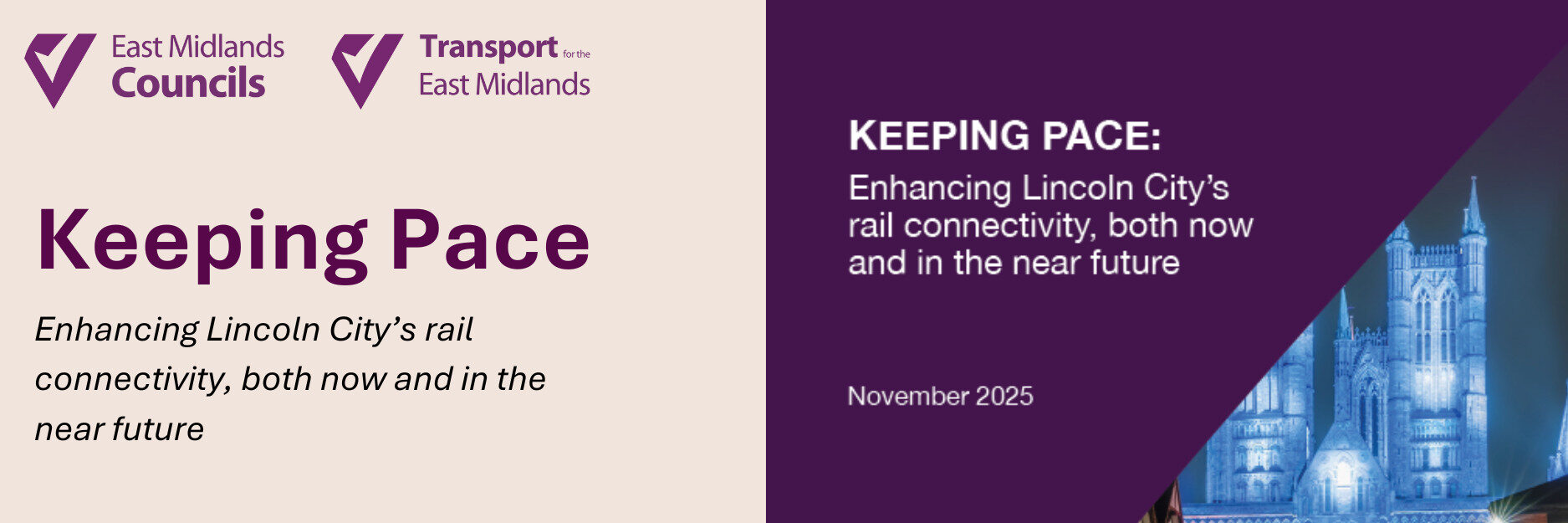A new report says upcoming enhancements to Lincoln’s rail services mark an important step forward, but states they must be safeguarded and built upon if the city’s growing population and economy are to be properly supported.

Keeping Pace: Enhancing Lincoln City’s Rail Connectivity shows that demand for rail travel in Lincoln continues to rise, even as national usage has fallen. While train use across Britain declined by 6 per cent between 2019 and 2024, passenger numbers at Lincoln Station increased by nearly 5 per cent to more than two million journeys a year.
Transport for the East Midlands (TfEM) and the Greater Lincolnshire Combined County Authority (GLCCA) say that the planned doubling of trains between Lincoln and Nottingham from December 2025 represents a long-awaited improvement, but the report warns that this is still vulnerable to change, and stresses the need for clear long-term commitments to secure further progress.
Sir Peter Soulsby, Chair of TfEM, said: “Lincoln is growing at a pace unmatched by its transport network. The new timetable will be a major step forward, but unless it’s safeguarded and built upon, the city risks slipping backwards again. This report makes a clear, evidence-based case for sustained investment in one of the East Midlands’ most important rail corridors.”
Dame Andrea Jenkyns DBE, Mayor of Greater Lincolnshire, said: “The new Greater Lincolnshire Combined County Authority is committed to working with the rail industry to improve rail services across the area. For Lincoln, rail services need to be more frequent and attractive to tourists, visitors and businesses alike.
“Despite promises made nearly ten years ago during the last rail franchise planning – such as better Sunday services – Lincoln’s regional rail connections still fall short of providing hourly service every day and lack proper integration across the network.”
The report also points to earlier progress on Lincoln’s London connections, noting that the introduction of six direct daily services led to a 51 per cent increase in travel to the capital. It says this shows what targeted investment can deliver, but warns that parts of this progress remain at risk, with a direct Sunday service due to be withdrawn from December 2025 and longer-term pressures on East Coast Main Line capacity creating uncertainty for Lincoln’s remaining London links.
Cllr Sean Matthews, Chair of the GLCCA Transport Board and Chair of East Midlands Councils, said: “People in Lincolnshire want a rail service that works. At the moment, it is still too slow, too infrequent and too easy for services to be cut back. Good rail links make a real difference to everyday life, whether it is getting to work, visiting family, going to hospital appointments or enjoying a day out without relying on the car. The demand is already there, and this report shows why Lincoln needs a fair deal and a network that keeps up with the city.”
The report also identifies a number of long-standing constraints that need to be addressed to support Lincoln’s future growth, including delayed signalling upgrades, slow line speeds on key sections of the network, and the limitations created by the Newark Flat Crossing. These issues, it argues, will need sustained attention if the city is to benefit fully from the upcoming timetable improvements and secure stronger regional and national connections in the years ahead.
Keeping Pace: Enhancing Lincoln City’s Rail Connectivity was produced by East Midlands Councils on behalf of Transport for the East Midlands (TfEM), in partnership with the Greater Lincolnshire Combined County Authority (GLCCA).
The full report is available here: Keeping Pace: Enhancing Lincoln City’s Rail Connectivity